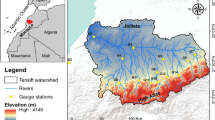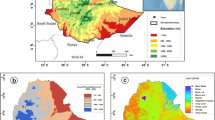Abstract
Orography of Himalaya governs the regional weather system and monsoon of Indian sub-continent. The intense persistent precipitation in the form of rainfall during monsoon season causes landslides which are the most frequent naturally occurring hazards in the Himalaya. This study attempts to investigate the spatio-temporal variability of precipitation and their effect on precipitation triggered landslides during monsoon season (June–September) in relation to relief in Himalayan region by utilizing satellite-derived precipitation products (GPM) over the span of 2000–2018 in addition to NASA Landslide Viewer, Global Landslide Catalog and Global Risk Data Platform data for landslides and ASTER DEM for elevation. The results exhibit that the Eastern Himalayas received the highest amount of precipitation of 2385 mm with intensity of 19.5 mm/day, followed by the Central Himalayas with 1860 mm and intensity of 17.5 mm/day and the least in the Western Himalayas with 1400 mm and intensity of 15 mm/day, respectively. The monsoon precipitation in the lower elevations (below 2600 m) are mostly responsible for causing a vast majority of the precipitation induced landslide events with a maximum of 68.66% in the Central Himalayas followed by the Western Himalayas at 62.23% and the least in the Eastern Himalayas at 41.16%. The overall accumulated precipitation and intensity during monsoon season and landslide distribution were strongly correlated with relief pattern. This comprehensive study signifies how relief regulated the occurrences of landslides in monsoon season and recommends vegetation cover and least interference of human-induced land use to alleviate the landslides.












Similar content being viewed by others
Availability of data and materials
Not applicable.
Code availability
Not applicable.
References
Chalise, S. R. (2001). An introduction to climate, hydrology, and landslide hazards in the Hindu Kush Himalayan region. In Landslide hazard mitigation in the Hindu Kush Himalayas.
Mei'e, R., Renzhang, Y., & Haosheng, B. (1985). An outline of China's physical geography.
Owens, L. A., Finakel, R. C., & Café, M. W. (2002). A note on the extent of glaciation throughout the Himalaya during the global last glacial maximum. Quaternary Science Reviews, 21, 147–157.
Dyurgerov, M. B., & Meier, M. F. (2005). Glaciers and the changing Earth system: A 2004 snapshot (Vol. 58). Boulder: Institute of Arctic and Alpine Research, University of Colorado.
Rajeevan, M., & Bhate, J. (2009). A high resolution daily gridded rainfall dataset (1971–2005) for mesoscale meteorological studies. Current Science, 96, 558–562.
Singh, P., & Bengtsson, L. (2004). Hydrological sensitivity of a large Himalayan basin to climate change. Hydrological Processes, 18(13), 2363–2385.
Parida, B. R., Pandey, A. C., & Patel, N. R. (2020). Greening and browning trends of vegetation in India and their responses to climatic and non-climatic drivers. Climate, 8(8), 92.
Gerrard, J. (1994). The landslide hazard in the Himalayas: Geological control and human action. In Geomorphology and natural hazards (pp. 221–230). Elsevier.
Froude, M. J., & Petley, D. N. (2018). Global fatal landslide occurrence from 2004 to 2016. Natural Hazards and Earth System Sciences, 18(8), 2161–2181.
Li, T. (1990). Landslide management in the mountain areas of China (Vol. 15). ICIMOD.
Basu, S. R., De, S. K., & Bera, B. (2009). Progress of research in landslide studies in India. Geomorphology in India (pp. 171–198). Allahabad: PrayagPustakBhawan.
Jana, M. M. (2002). Application of remote sensing in the study of geomorphic processes and lanforms in piedmont zone of Darjeeling Sub-Himalaya. Journal of the Indian Society of Remote Sensing, 30(1–2), 61.
Biswas, S. S., & Pal, R. (2016). Causes of landslides in Darjeeling Himalayas during June–July, 2015. Journal of Geography and Natural Disasters, 6(173), 2167–2587.
Dahal, R. K. (2012). Rainfall-induced landslides in Nepal. International Journal of Erosion Control Engineering, 5(1), 1–8.
Dubey, C. S., Chaudhry, M., Sharma, B. K., Pandey, A. C., & Singh, B. (2005). Visualization of 3-D digital elevation model for landslide assessment and prediction in mountainous terrain: A case study of Chandmari landslide, Sikkim, eastern Himalayas. Geosciences Journal, 9(4), 363.
Dikshit, A., & Satyam, D. N. (2018). Estimation of rainfall thresholds for landslide occurrences in Kalimpong, India. Innovation Infrastructure Solution, 3, 1–10.
Dikshit, A., Sarkar, R., Pradhan, B., Segoni, S., & Alamri, A. M. (2020). Rainfall induced landslide studies in Indian Himalayan region: A critical review. Applied Sciences, 10(7), 2466.
Kanungo, D. P., & Sharma, S. (2014). Rainfall thresholds for prediction of shallow landslides around Chamoli-Joshimath region, Garhwal Himalayas, India. Landslides, 11(4), 629–638.
Shrestha, A. B., Wake, C. P., Dibb, J. E., & Mayewski, P. A. (2000). Precipitation fluctuations in the Nepal Himalaya and its vicinity and relationship with some large scale climatological parameters. International Journal of Climatology: A Journal of the Royal Meteorological Society, 20(3), 317–327.
Stanley, T., Kirschbaum, D. B., Pascale, S., & Kapnick, S. (2020). Extreme precipitation in the Himalayan Landslide Hotspot. In Satellite precipitation measurement (pp. 1087–1111). Cham: Springer.
Jaber, S. M. (2020). Comparative evaluation of statistically downscaling Tropical Rainfall Measuring Mission (TRMM) and Global Precipitation Measurement (GPM) mission precipitation data: evidence from a typical semi-arid to arid environment. Spatial Information Research, 1–8.
Kumar, M. S., Shekhar, M. S., Krishna, S. R., Bhutiyani, M. R., & Ganju, A. (2012). Numerical simulation of cloud burst event on August 05, 2010, over Leh using WRF mesoscale model. Natural Hazards, 62(3), 1261–1271.
Ives, J. D., & Messerli, B. (1989). The Himalayan dilemma: Reconciling development and conservation. London: Wiley.
Bhutiyani, M. R., Kale, V. S., & Pawar, N. J. (2007). Long-term trends in maximum, minimum and mean annual air temperatures across the Northwestern Himalaya during the twentieth century. Climatic Change, 85(1–2), 159–177.
Jhajharia, D., & Singh, V. P. (2011). Trends in temperature, diurnal temperature range and sunshine duration in Northeast India. International Journal of Climatology, 31(9), 1353–1367.
IPCC: Climate Change 2013. (2013). The physical science basis. In T. F. Stocker, D. Qin, G.-K. Plattner, M. Tignor, S. K. Allen, J. Boschung, A. Nauels, Y. Xia, V. Bex, & P. M. Midgley (Eds.), Contribution of working group I to the fifth assessment report of the Intergovernmental Panel on Climate Change. Cambridge: Cambridge University Press. https://doi.org/10.1017/CBO9781107415324
UNEP. (2009). Mountains as early indicators of climate change. In Proceedings of the International Conference, 17–18 April 2008, Padova, Italy.
Thiede, R. C., Ehlers, T. A., Bookhagen, B., & Strecker, M. R. (2009). Erosional variability along the northwest Himalaya. Journal of Geophysical Research: Earth Surface, 114(F1), F01015.
Shukla, D. P., Dubey, C. S., Ningreichon, A. S., Singh, R. P., Mishra, B. K., & Singh, S. K. (2014). GIS-based morpho-tectonic studies of Alaknanda river basin: A precursor for hazard zonation. Natural Hazards, 71(3), 1433–1452.
Thiede, R. C., Bookhagen, B., Arrowsmith, J. R., Sobel, E. R., & Strecker, M. R. (2004). Climatic control on rapid exhumation along the Southern Himalayan Front. Earth and Planetary Science Letters, 222(3–4), 791–806.
Bookhagen, B., Thiede, R. C., & Strecker, M. R. (2005). Late Quaternary intensified monsoon phases control landscape evolution in the northwest Himalaya. Geology, 33(2), 149–152.
Bookhagen, B., & Burbank, D. W. (2006). Topography, relief, and TRMM-derived rainfall variations along the Himalaya. Geophysical Research Letters, 33(8), L08405.
Dubey, C. S., Shukla, D. P., Ningereichon, A. S., & Usham, A. L. (2014). Orographic control of the Kedarnath disaster. Current Science, 105(11), 1474–2147.
Dimri, A. P., Chevuturi, A., Niyogi, D., Thayyen, R. J., Ray, K., Tripathi, S. N., & Mohanty, U. C. (2017). Cloudbursts in Indian Himalayas: a review. Earth-Science Reviews, 168, 1–23.
Acknowledgements
The authors would like to acknowledge all the data providing sources such as NASA’s Giovanni, Global Landslide Catalog (GLC), Global Risk Data platform and USGS for allowing free data access of all the required data sets incorporated during the course of this study.
Funding
Not applicable.
Author information
Authors and Affiliations
Corresponding author
Ethics declarations
Conflict of interest
There is no conflict of interest among the authors.
Additional information
Publisher's Note
Springer Nature remains neutral with regard to jurisdictional claims in published maps and institutional affiliations.
Rights and permissions
About this article
Cite this article
Kashyap, R., Pandey, A.C. & Parida, B.R. Spatio-temporal variability of monsoon precipitation and their effect on precipitation triggered landslides in relation to relief in Himalayas. Spat. Inf. Res. 29, 857–869 (2021). https://doi.org/10.1007/s41324-021-00392-8
Received:
Revised:
Accepted:
Published:
Issue Date:
DOI: https://doi.org/10.1007/s41324-021-00392-8




